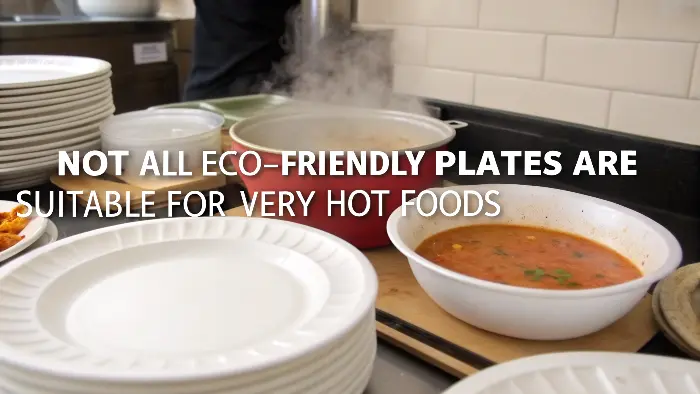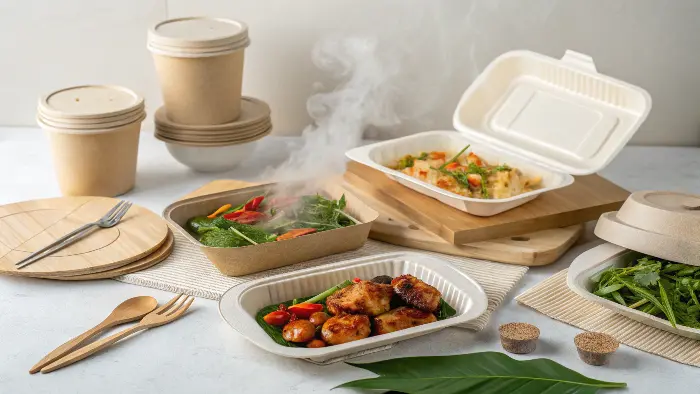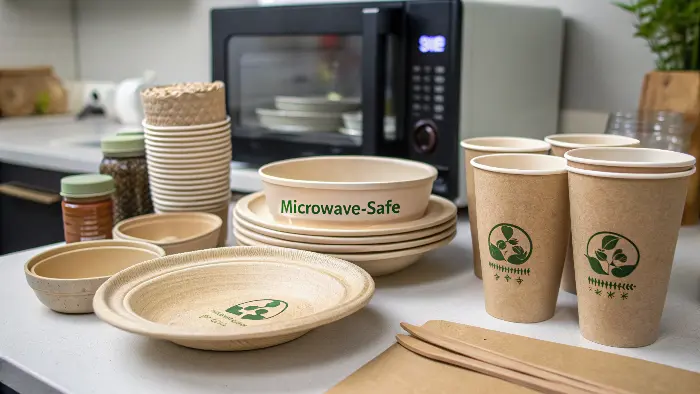Tired of eco-plates wilting under your hot chili? It’s frustrating when good intentions lead to messy meals. But don’t worry, truly heat-sturdy, green options are out there!
For piping hot foods, bagasse (sugarcane) tableware is a fantastic choice. It’s strong, handles heat well, and is fully compostable. Many other materials also offer good heat resistance, giving you solid, sustainable alternatives to plastic.
Okay, so we know some eco-friendly stuff can handle the heat, but what’s the real deal? I’ve been down this road, trying to serve a steaming stew at a family picnic only to have the plate practically melt. Not a good look! So, let’s dig into what actually works when you’re dishing out hot meals and want to stay green. You might be surprised by what I found out.
Why is Bagasse Tableware So Good for Hot Stuff, Anyway?
Ever wonder what makes some eco-tableware tough against heat? It’s a real pain when you expect strength and get a floppy mess. The secret often lies in the material’s natural properties.
Bagasse, made from sugarcane fiber, excels with hot foods because its dense, fibrous structure is naturally heat-resistant and strong. This means no warping or leaking, even with very hot or oily dishes, making it super reliable.
So, I was looking into this because, honestly, I was skeptical. "Sugarcane? For my lasagna?" I thought. But yeah, it’s pretty cool how it works. Bagasse is basically the leftover pulp after sugarcane stalks are crushed to get their juice. This fiber is then re-purposed to make disposable tableware, offering an eco-friendly alternative to plastic. Instead of just tossing this fibrous stuff, it gets a new life. That’s a win right there for sustainability, right? Bagasse tableware is not only biodegradable but also heat-resistant and microwaveable, making it a practical choice for both hot and cold foods.
How Does it Hold Up?
The magic is in the fibers themselves. They’re naturally tough and can withstand pretty high temperatures – often up to 200°F (or around 93°C), sometimes even more. I once served some seriously hot curry on a bagasse plate at a backyard barbecue, and it held up like a champ. No sogginess, no weird taste transfer, nothing. My guests were impressed, and so was I! It’s this natural resilience that makes it so great.
Key Advantages of Bagasse for Hot Foods:
| Feature | Benefit for Hot Foods | My Experience |
|---|---|---|
| Heat Resistance | Doesn’t melt or deform easily. | Served boiling soup, no problem! |
| Strength | Sturdy enough for heavy, hot meals. | Handled a full plate of pasta without bending. |
| Oil & Water Proof | Resists grease and liquids from hot dishes. | No leaks with saucy stir-fries. |
| Microwavable | Can often be used for reheating (check manufacturer). | Reheated leftovers – super convenient. |
| Biodegradable | Breaks down naturally post-use. | Peace of mind knowing it won’t linger in landfills. |
It’s not just about heat; it’s about the combination of heat resistance, strength, and being grease-proof. That’s what makes bagasse a real winner for me when I’m serving anything hot. And knowing it’ll compost later? Chef’s kiss! 🔥
Are All "Eco" Plates Safe for My Steaming Hot Soup Then?
You see "eco-friendly" and think "great!" But hold on, will it survive your grandma’s famous hot soup? Not all green options are created equal when it comes to heat.
No, not all eco-friendly plates are suitable for very hot foods. While many are, some, like certain thin paper plates or some PLA items not designed for high heat, might warp or soften. Always check the product specifics!

This is a big one, folks. I learned this the hard way. I once bought some "biodegradable" plates for a chili cook-off. They looked sturdy enough. But when the steaming hot chili hit them… well, let’s just say things got a bit wobbly and messy. It was a lesson in reading the fine print! The term "eco-friendly" is broad, and it doesn’t automatically mean "heatproof." You’ve got to be a bit of a detective sometimes.
What to Watch Out For:
- Thin Paper Plates: Unless they’re specifically treated or coated for heat (and that coating itself is eco-friendly), very thin paper plates can get soggy and lose their shape fast with hot, wet foods. I mean, think about a regular paper napkin trying to hold soup – same idea. It’s just not built for that kind of challenge.
- Standard PLA (Polylactic Acid): PLA is awesome, it’s made from cornstarch or other plant sugars. But standard PLA has a relatively low heat deflection temperature, often around 114-140°F (45-60°C). So, for your lukewarm coffee cup lid, it might be fine. But for boiling soup? Not so much, unless it’s CPLA. It’ll likely soften and could even deform.
- Recycled Paper (sometimes): Some recycled paper products might not have the same structural integrity or heat resistance as virgin fiber products or bagasse, depending on how they’re made and the source of the recycled material. It’s not a hard and fast rule, but something to be aware of.
So, What’s the Deal with CPLA?
Now, there’s something called CPLA (Crystallized Polylactic Acid). This is where PLA gets a bit of a superpower boost for heat. Through a special process, the PLA is crystallized, which significantly raises its heat tolerance – often up to 185°F (85°C) or even higher. So, if you see CPLA cutlery or lids, they are designed for hot stuff. I always look for that "C" if I’m considering PLA for hot applications. It makes a huge difference. It’s like the difference between a regular t-shirt and a thermal undershirt – both are fabric, but one handles the cold (or in our case, heat) way better! This is super important for things like coffee cup lids or cutlery that will definitely encounter high temperatures.
Beyond Bagasse: What Other Heat-Friendly Eco Options Can I Trust?
Bagasse is great, sure, but what if you want variety or can’t find it? Are there other trusty eco-materials for hot foods? Good news – there are other strong contenders out there!
Yes! Besides bagasse, look for palm leaf plates, CPLA (crystallized PLA) cutlery and lids, and some specially treated paper products. These can often handle significant heat, offering more sustainable choices for your hot meals.

I love having options, don’t you? While bagasse is often my go-to, it’s good to know what else is on the market. Especially if, say, your supplier is out of bagasse or you’re looking for a different aesthetic for a special event. I’ve experimented with a few, and let me tell you, some are pretty impressive.Other Eco-Warriors for Heat:
- Palm Leaf Plates: These are pretty amazing. They’re made from fallen areca palm leaves – so no trees are cut down! The leaves are just collected, cleaned, and heat-pressed into shape. They are super sturdy, have a beautiful, unique rustic look, and can handle hot, cold, and oily foods like a boss. I used them for a fancy outdoor dinner once, and people couldn’t stop talking about how elegant they looked. They are also compostable, which is a huge plus. Definitely a bit more premium in feel, but for the right occasion, they are fantastic.
- CPLA (Crystallized Polylactic Acid): We touched on this, but it deserves another mention because it’s so versatile. CPLA cutlery (forks, knives, spoons) is a game-changer for hot foods if you need disposables. Regular PLA cutlery can get bendy in hot soup or when stirring hot coffee. CPLA doesn’t. I always keep a stash of CPLA spoons for our office coffee station. They also make CPLA lids for hot cups, which are much better than standard PLA lids for, say, a very hot tea or coffee.
- Bamboo: Bamboo products, especially reusable ones, are naturally heat resistant and very durable. For disposable options, you might find some bamboo pulp plates or bowls, or even elegant-looking disposable bamboo cutlery. These are generally quite strong and handle heat well. Bamboo grows super fast, making it a highly renewable resource. I’ve seen some really nice disposable bamboo boats for appetizers that hold up great and add a nice touch.
- Specially Coated/Treated Paper: Some paper products are designed with food-safe, heat-resistant coatings (often plant-based waxes or PLA linings) that allow them to handle hot liquids and foods without disintegrating. The key here is "specially treated" or "heavy-duty." Your average cheap paper plate won’t cut it, but brands that specialize in food service paper products often have lines that are pretty robust. Always check what the coating is made of if compostability is a high priority for you.
It’s all about finding the right tool for the job, right? Just like you wouldn’t use a butter knife to chop an onion. Knowing these alternatives helps me make better choices depending on the event, the food, and the vibe I’m going for. It’s good to have a whole arsenal of eco-friendly options!How Can I Be Sure My Eco Tableware is Really Microwave-Safe?
"Microwave-safe" on an eco-label sounds great, but can you trust it? You don’t want a melted mess or weird chemicals in your food. So, how do you know for sure?
Check the manufacturer’s instructions or packaging for a "microwave-safe" symbol or statement. Materials like bagasse and some CPLA are often microwavable, but always confirm. Avoid microwaving if unsure, especially with PLA that isn’t CPLA.

This is a question I get asked a lot, especially from people new to eco-tableware. And it’s a valid concern! Nobody wants to turn their microwave into a science experiment gone wrong, or worse, leach something funky into their food. I once assumed a "biodegradable" container was microwave-safe… it wasn’t. The corner sort of slumped. Oops. Lesson learned: always, always check. Don’t just guess!Verifying Microwave Safety:
- Look for the Label: This is the most straightforward way. Reputable manufacturers will clearly state if their product is microwave-safe, often with that wavy line symbol or text. This is your first port of call. My bagasse plates, for example, clearly state they are microwave-safe up to a certain temperature and for a limited time (e.g., "up to 2 minutes").
- Know Your Materials (Generally):
- Bagasse (Sugarcane): Generally, yes. It handles reheating well. I use it all the time for leftovers.
- Palm Leaf: Typically yes, for short periods of reheating. They are quite robust, but I wouldn’t use them for extensive cooking in the microwave.
- PLA (Standard): Usually NO. It has a low melting point and can warp or melt. You might get away with very, very low power for a few seconds, but I wouldn’t risk it.
- CPLA (Crystallized PLA): Often yes, for reheating. Again, check the label. CPLA lids for coffee cups are designed for heat but not necessarily for prolonged microwaving of the cup itself if the cup is standard PLA.
- Paper (Coated/Treated): Some are, some aren’t. It depends heavily on the type of paper and any lining or coating. If it has a plastic-y lining (even if it’s PLA), check if that specific lining is microwave-safe. Some coatings can melt or release odors.
- When in Doubt, Don’t: If there’s no clear indication, or if you’re unsure about the material, it’s safer to transfer the food to a known microwave-safe dish (like ceramic or glass) before heating. Better safe than sorry, right? It takes an extra second but saves potential trouble.
- Test a Small Piece (Cautiously and Rarely): If you’re really stuck and have an identical spare item you’re willing to sacrifice, you could test a small, empty piece in the microwave for a very short burst (like 15-20 seconds) on medium power. See if it sparks, melts, deforms, or gets excessively hot. This is a last resort, and I don’t really recommend it as a regular practice because results can vary.
Remember, "eco-friendly" doesn’t automatically equal "microwave-safe." And even if it is, there are usually limits – don’t go nuking something for 10 minutes on high if the instructions say 2 minutes on medium. It’s all about using common sense and following the guidelines. This is especially important for us at Ecosourcecn when advising clients; we need to be crystal clear about product capabilities and limitations to ensure they have the best experience!Conclusion
So, choosing heat-resistant eco-tableware isn’t tricky if you know what to look for. Bagasse is a star, but other great options exist for your hot meals!


